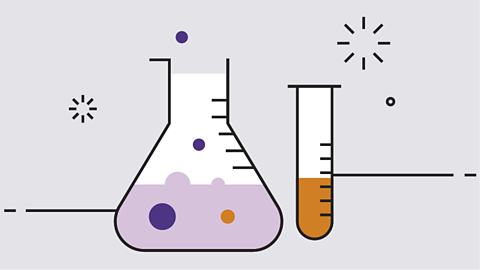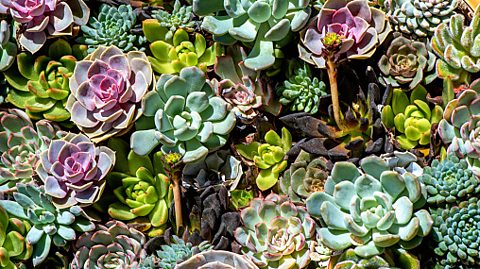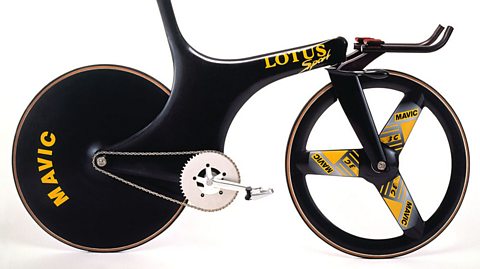Key Points
- Polymers are very long chain molecules made from small repeating units called monomers.
- Polymers occur naturally, but can also be manufactured.
- Synthetic polymers are better known as plastics and have a range of uses.
All polymers are plastics, true or false?
False.
Plastics are synthetic polymers, but there are other natural polymers too.

Video
Watch this video about plastics to see how plastic polymerA polymer is a very long chain molecule made up of many repeating units. are made.
While youÔÇÖre watching, look out for the link between the petrochemicalSubstance made from crude oil using chemical reactions. industry and plastics.
Plastics are polymers and that's Greek for many parts. So they're a bit like this chain of paperclips. They're individual components linked together.
Although in the case of plastics, the individual components are molecules containing mostly carbon and hydrogen. And the key thing is that they can join together to form long chains.
Now in the 1920s, when scientists realised this is what plastics looked like, it opened up new possibilities for making plastics. Because before then, well, the chemical reactions they were using were a bit of a mystery. But then they realised that they only had to find molecules that would link together and they could create loads of new plastics.
And in one of those great moments in history where knowledge and opportunity coincide, scientists realised that a vast source of raw ingredients for these new plastics had already been discovered.
With the proliferation of the motorcar and expansion of industry and cities, enormous quantities of oil and gas were being pumped out of the ground and processed into fuel.
And the products of oil and gas refineries were hydrocarbons, containing exactly the kind of molecules that could join up to make plastics.
Cheap and abundant, everything was now in place or the plastics explosion.
Nylon, PVC, polystyrene, polyester. All destined to become household names.
What is the name of the type of waste products from the petrochemical industry that were used to make the first plastics?
Hydrocarbons.
Hydrocarbons are compounds containing only carbon and hydrogen atoms.
In the ball and stick models of simple hydrocarbons below, carbon atoms are black and hydrogen atoms are white.
What are polymers?
A polymer is a very long moleculeA cluster of atoms that are chemically bonded together in a fixed ratio. Molecules are always made from non-metal atoms. A molecule can be represented with a chemical formula, for example, OÔéé or CHÔéä.. Polymers are made up of many repeating units called monomerA monomer is the smallest part of a polymer. Many monomers repeat in a chain to make a polymer. .
A daisy chain is a good model for a polymer. Each individual daisy represents a monomer. As they join together to make a long chain, they make a model of a polymer.


Did you know?
The scientific names polymer and monomer come from Ancient Greek.
ÔÇśPolyÔÇÖ means many, and ÔÇśmerÔÇÖ means part, so polymer literally means something that is made of ÔÇśmany parts.ÔÇÖ
ÔÇśMonoÔÇÖ means one, so a monomer is ÔÇśone partÔÇÖ of a polymer.

Natural polymers
Some polymers are naturally occurring like cellulose, DNA and proteins.

Cellulose is the main substance in the walls of plant cells. It helps plants to remain stiff and upright.
The monomer of cellulose is simple sugars. The simple sugars join together in a long chain molecule to form the polymer cellulose.
| Natural polymer | Natural monomer |
|---|---|
| Cellulose | Simple sugars |
| DNA | Nucleic acids |
| Protein | Amino acids |


Did you know?
Your fingernails and hair are made from a protein called keratin, which is a polymer. Keratin is also what rhinocerosÔÇÖ horns are made from.

Why is a polymer present in plant cell walls?
To provide support to the plant.
The polymer is called cellulose which is made from very long molecules. This makes the cellulose strong but flexible. When the cells are full of water, the cellulose in the cell walls gives the cells a fixed shape. This means when many cells are in a plant structure like a stem or a leaf, they can keep the plant upright.
Synthetic polymers
syntheticA synthetic substance is one made by chemical reactions rather than by nature. polymers are manufactured using chemical reactions that join lots of small molecules together to make long molecules. For example, polycarbonate is a synthetic polymer used to make the lenses for glasses.
Have a look at the diagram to see how ethene molecules join together to make long molecules of the synthetic polymer called polyethene.
Synthetic polymers are best known by their common name, plastics. Plastics are all around us. They are one of our most useful materials.
There are many different monomers that can be used to make plastics, so polymers can be designed for specific uses.
Synthetic polymers often have these propertyA quality, or characteristic, of something. Physical properties of matter are measurable - for example, melting point or boiling point. in common:
- they are chemically unreactive
- they are solids at room temperature
- they can be moulded into shape
- they are electrical insulators
- they are strong and hard-wearing
Have a look through the slideshow to understand how plastics are used every day.

Image caption, PVC, polyethylene or polyester is used to coat the outside of electrical wires because synthetic polymers are electrical insulators.
Image caption, These chairs are made from poly(propylene) because synthetic polymers are strong and hardwearing.
Image caption, Synthetic polymers are chemically unreactive which is important for their use as containers for chemicals like bleach.
Image caption, Food wrappers also need to be made from chemically unreactive materials, so synthetic polymers are commonly used.
1 of 4
Synthetic polymers tend to have names including the word ÔÇśpolyÔÇÖ. For example, polyethene or polystyrene. Some are better known by their common names like nylon or elastane.
| Polymer name | Typical use | Properties |
|---|---|---|
| Polyethene or polythene | Plastic bags | Strong, hard-wearing |
| Polyvinyl-chloride (PVC) | Water pipes | Strong, hard-wearing, chemically unreactive |
| Polyvinyl-chloride (PVC) | Outer layer of electrical wires | Electrical insulator, hard-wearing |
| Nylon (polyamide) | Clothing | Can be made into fibres, strong, flexible |
| Elastane | Sports clothing | Can be made into fibres, very elastic, tough |
Disadvantages of polymers
Polymers are usually chemically unreactive. This is a useful property because it means that plastic bottles will not react with their contents.
For example, a fruit juice drink contains lots of different acids. It is important that the plastic in a drink bottle doesnÔÇÖt react with them.
Unfortunately, this lack of reactivity also makes polymers difficult to dispose of. When they are thrown away, they do not break down very quickly and so stay in the environment for a long time. Plastic pollution poses a big environmental challenge.

Plastics break down even more slowly in water. Plastic is used for fishing ropes as it is strong and durable. When fishing gear is lost in water it sinks and is known as ÔÇśghost gearÔÇÖ because it no longer belongs to a boat. This ghost gear can entangle sea creatures.
Find out more about the problems that ghost gear causes in this Newsround article.

The term polymer refers to a very long molecule made of repeating smaller molecules that have been joined together. Polymers can be natural or synthetic. Synthetic polymers are also known as plastics.
Acrylic is used in the manufacture of the types of plastic windows used in structures like bus shelters. What properties might acrylic have?
| Polymer name | Typical use | Properties |
|---|---|---|
| Acrylic | Plastic windows | Strong, does not shatter, see-through |
Working Scientifically
Variables
Reusable plastic carrier bags are sold by supermarkets so that customers can reduce the amount of plastic waste they throw away. The plastic must be strong so that the bags can be reused many times. Different polymers have differences in their strengths.
The strengths of polymers can be compared by conducting this experiment involving plastic from different reusable carrier bags.
- Cut strips 15 cm long and 3 cm wide from at least two different reusable plastic bags.
- Tie the two ends of the strip together to form a loop. Place the loop around the clamp.
- Attach a 50 g mass to the plastic loop using a mass hanger. Continue adding 50 g masses until the plastic breaks.
- Continue steps 2 and 3 with the strips of plastic from different bags and record your results in a table.
| Type of plastic bag | Maximum weight possible (g) |
|---|---|
| Supermarket A | 300 |
| Supermarket B | 550 |
An independent variable is the variable that is changed during the experiment. The dependent variable is the variable being tested or measured.
What are the independent and dependent variables of the experiment above?
Independent variable: The type of plastic bag
Dependent variable: The mass required to break the bag

Control variables are the variables that need to be kept the same so that the experiment is a fair test.
What control variables are needed in the experiment above?
The width and length of the plastic bag loops.
To learn more about variables in Chemistry, read this Working Scientifically guide.
Activity
Look around where you are now and make a list of all the items you see that is made of a synthetic polymer. Complete the table listing the items and the important properties for each item.
- Chemically unreactive
- Solids at room temperature
- Plastic ÔÇô they can be moulded into shape
- Electrical insulators
- Strong and hard-wearing
| Name of item | Important properties |
|---|---|
| Ballpoint pen casing | 1, 2, 3 |
| TV casing | 2, 3, 4 |
Test Your Knowledge
Quiz
Play the Atomic Labs game! gamePlay the Atomic Labs game!
Try out practical experiments in this KS3 science game.

More on Materials
Find out more by working through a topic
- count3 of 3

- count1 of 3
